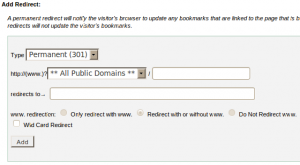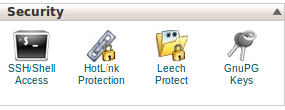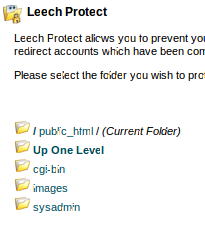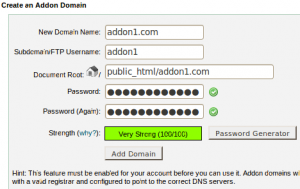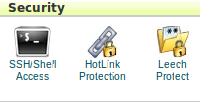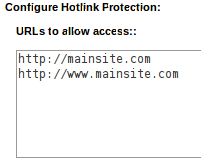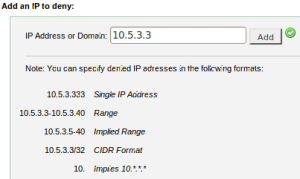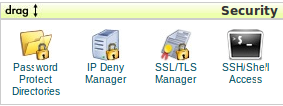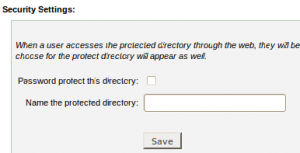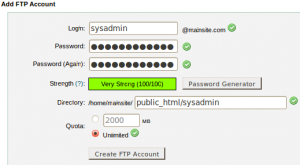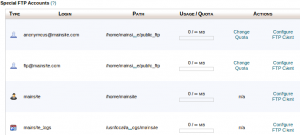Redirects allow you to make a specific web page redirect to another page and display the contents of that page.
1) Click on the Redirects button on the home page.
2) To add a new Redirect
a) Select the type of redirection needed, either temporary or permanent from the combo box “Type”.
b) Enter the URL you would like to redirect in the combo box and corresponding text box “http://(www.)?”.
c) Enter the URL to which you would like to redirect users in the “redirects to” text box .(Specify a address with a protocol ie, http://, https:// or ftp:// ) .
d) Select any one of the option listed below.
Only redirect with www – Only users who type “www” in front of the page name will be redirected.
Redirect with or without www – Redirect all users regardless of whether the “www” prefix is included with the URL.
Do Not Redirect www – users who type ” www” with the URL will not be redirected.
e) Click the check box ““, to redirect all files to the same filename in the redirected URL.
f) Click the button “Add” to add the new redirects.
You may test the redirect by clicking the link under ” Directory “ in the Current Redirects.
a) Click the corresponding redirect link under remove, to remove a redirect.
Remote MySQL option is to allow an external web server to access your MySQL databases.
1) Click on the “Remote MySQL” in the home screen under Databases.
2) To allow a remote server to access your databases
a) Type the host’s name or IP address into the text field “(% = wildcard , with % all external servers will be able to access your databases )”.
b) Click on “Add Host” to add a specified host to access the MySQL databases.
3) To disallow a host from accessing databases on your server.
Click the button below Remove of the corresponding host’s name or IP address.
Leech Protect allows you to prevent users from publicly posting their password to a restricted area of your site. If an user A is given access to a restricted area and he passes the login to user B and user C with different IP’s , leech protect will detect this and block these IP’s. It also can prevent people from attempting to guess a user’s password through repeated guesses.
1) To protect your website from leeching, click on the “Leech Protect” on the home screen under Security.
2) Select the folder you wish to protect by clicking on its name.
3) Enter the number of times a user may login to this folder during a 2 hour period in the text box “Number of Logins Per Username Allowed in a 2-Hour Period”.
4) Enter the web address of a site you wish to send users to who violate the
maximum number of logins.
5) For enabling email alerts, click on the check box near “Send Email Alert To”.
Enter the email address which the email alerts wants to be sent in the text box near “Send Email Alert To”.
6) Click the “Disable Compromised Accounts” checkbox for disabling an account that exceeds the maximum number of logins in 2 hours .
7) Click on Enable button to enable leech protection.
Click on Disable button to disable leech protection.
8) There is a “Manage Users” button, clicking this button takes you to the “Password Protect Directories” where you can add,edit or delete an user.
Parked Domains allow you to “point” or “park” additional domain names to your existing hosting account main domain. Park domain will show the same content of your main domain.
1) Click on the “Parked Domains” button on the home page under Domains.
2) Enter the domain you wish to park in the available text field.
Click ” Add Domain“, to add the Parked Domain.
3) Existed Parked Domain are listed under the “Remove Parked Domains”.
a) Click the link under ” Domain Root” that corresponds to the Parked domain, for viewing the file manager.
b) To Enable or Disable redirection of a parked domain , click on the link “Redirects to“.
Enter the url to which you would like to redirect the parked domain in the text box.
To disable the redirect, click the button “Disable Redirection“.
c) For deleting a parked domain , click the “Remove” link corresponding to the parked domain .
Addon domains are a way of creating separate domain within your master account. Addon domain will act as separate domain and you can manage it with the same main domain control panel.
1) Click on the Addon Domains button on the home page.
2) To add an addon domain
a) Enter the addon domain name in the “New Addon Domain” text box.
b) Enter the main FTP username for the addon domain in the ” Subdomain/Ftp Username” field.
c) Enter the directory that will contain the addon domain’s files in the text box ” Document Root“.
d) Enter the password for the addon domain in the “Password” field or use “Password Generator” to generate a strong password.
e) Click “Add Domain” to save the new addon.
3) Existed Addon Domain are listed under the “Modify a Addon Domain“.
a) Click the link under ” Document Root” that corresponds to the addon domain, for viewing the file manager.
b) To Enable or Disable addon domain Redirection, click on the link ” Redirects to”.
Enter the link you would like to redirect the addon domain in the text box.
To disable the redirect, click the button “Disable Redirection“.
c) For deleting a addon domain , click the “Remove” link corresponding to the addon domain .
A Subdomain is a domain using your main domain and a prefix name. A subdomain is a domain that is part of a larger domain, for example blog.example.com is the subdomain of example.com
1) Click on the Subdomains button on the home page under the section “Domains”.
2) To create a subdomain
a) Enter the prefix for the subdomain in the text box “Subdomain“.
b) Select the desired main domain from the combo box.
c) Enter the home directory for the subdomain in the text box “Document Root“, you must upload the subdomains files to this directory.
d) Click the button “Create” to add the subdomain.
3) Existing subdomains are listed under the “Modify a Subdomain”.
a) Click the link under ” Document Root” that corresponds to the subdomain, for viewing the file manager.
b) To Enable or Disable Subdomain Redirection, click on the link ‘”Manage Redirection”.
Enter the url to which you would like to redirect the subdomain in the text box.
To disable the redirect, click the button “Disable Redirection“.
c) For deleting a sub domain, click the “Remove“ link corresponding to the subdomain.
You can use hotlink protection to keep other sites from linking to your images, videos, and other files.
1) To access Hotlink Protection, click on “Hotlink Protection” button on the home page under Security.
2) To Enable / Disable HotLink Protection, click the Enable button on the HotLink Protection main page.
In configure hotlink protection add urls of sites that you wish to access your files.
Direct access to certain file extensions can be blocked by adding them under ” Block direct access for these extensions”.
Click the checkbox to allow users to access the content directly by entering the specific file’s URL into a browser.
Requests for content can be redirected by entering a URL under the “Redirect request to this URL”.
Click the button “Submit” to save the entire setting.
IP Deny Manager is use to block single IP address or a range of IP addresses to prevent them from accessing your site.
1) To access the IP Deny Manager , click on the “IP Deny Manager” on the home page under Security.
2) Enter the IP address that you want to block in the IP Address field.We can also add a range of IP’s.
Click on the Add button.
3) Blocked IP addresses are seen under “Current IP addresses being blocked”.
To unblock an IP , Click Remove button near appropriate IP address
You can protect directories within your site with a login and password, by using this feature.
1) Click on “Password Protect Directories” button in Security session.
2)To password protect a directory, select the directory which you want to protect
a) Click on the option button “
b) Enter a name that you choose for the protect directory will appear.
c) Click “save”, to save the password protected file name.
3) You will need create a user and password under the”Create User”.
a) Enter the username.
b) Enter a strong new password or use “Password Generator”.
c) Click “Add/modify authorized user” to save the authorized user.
4) The new user’s name will be added to the list box under the Authorized Users heading.
We can also delete the desired users from the listbox by clicking “Delete User”.
To remove password protection from the directory, uncheck “Password protect this directory”.
Adding an FTP account will allow users to access the domain’s folder on the server’s hard disk.
1) For creating FTP accounts, click “FTP Accounts” in the “File” area.
2) To create a FTP account
a) Enter a username in the text box “Login“.
b) In the Password box, type the account’s password or generate a strong password by clicking the “Password Generator” button.
c) Enter the path to the “Directory” to which this FTP account has access.
d) Disk space that will be allocated to the FTP account can be set in “Quota” field.
e) Click Create FTP Account.
3) The new FTP account should be now displayed in the list below.
By Clicking the links we can change a password,Adjust quota,Delete an account or Configure an FTP client of an existing FTP Account.
4) Special FTP Accounts are seen under “Special FTP Accounts”.
Special FTP Accounts are FTP accounts that cannot be deleted.



